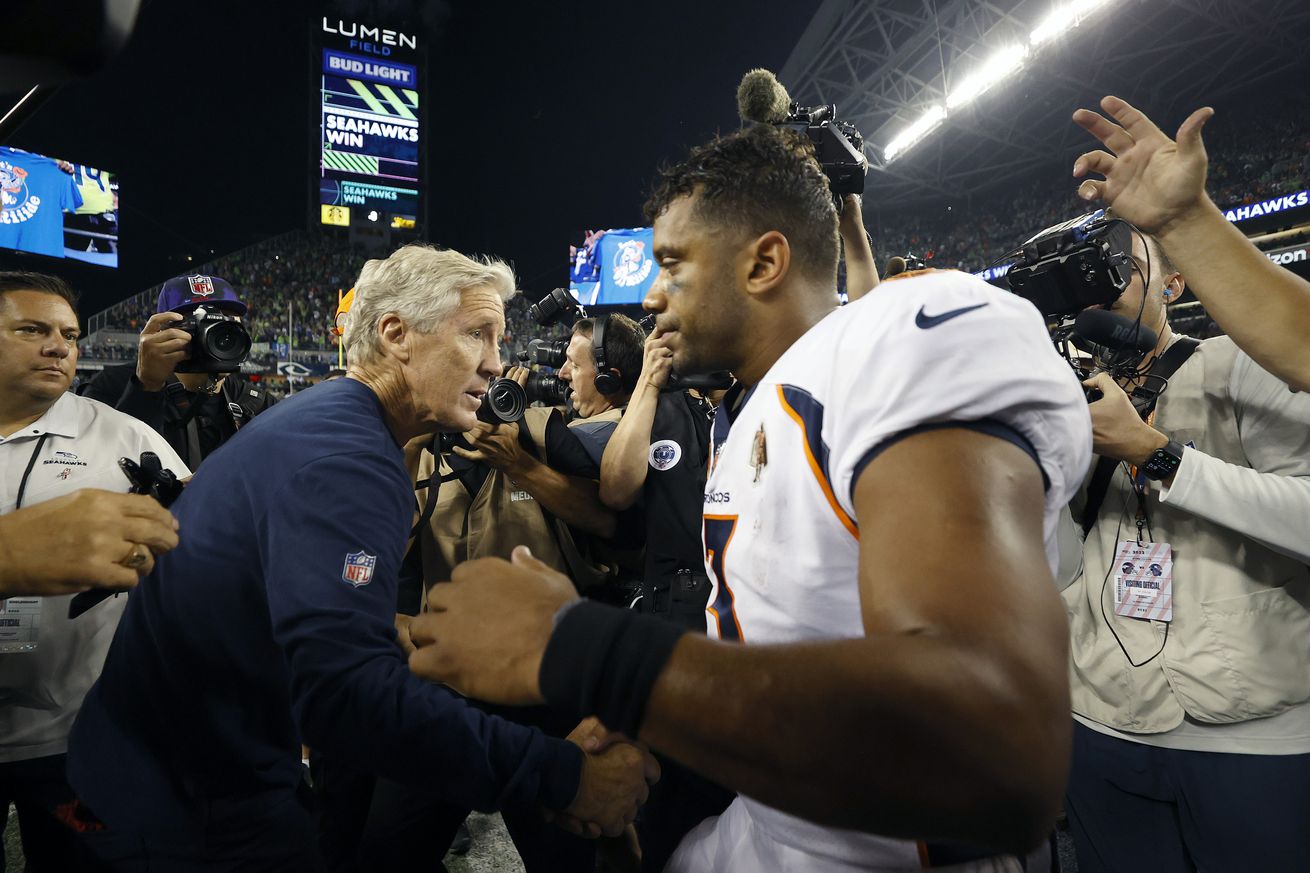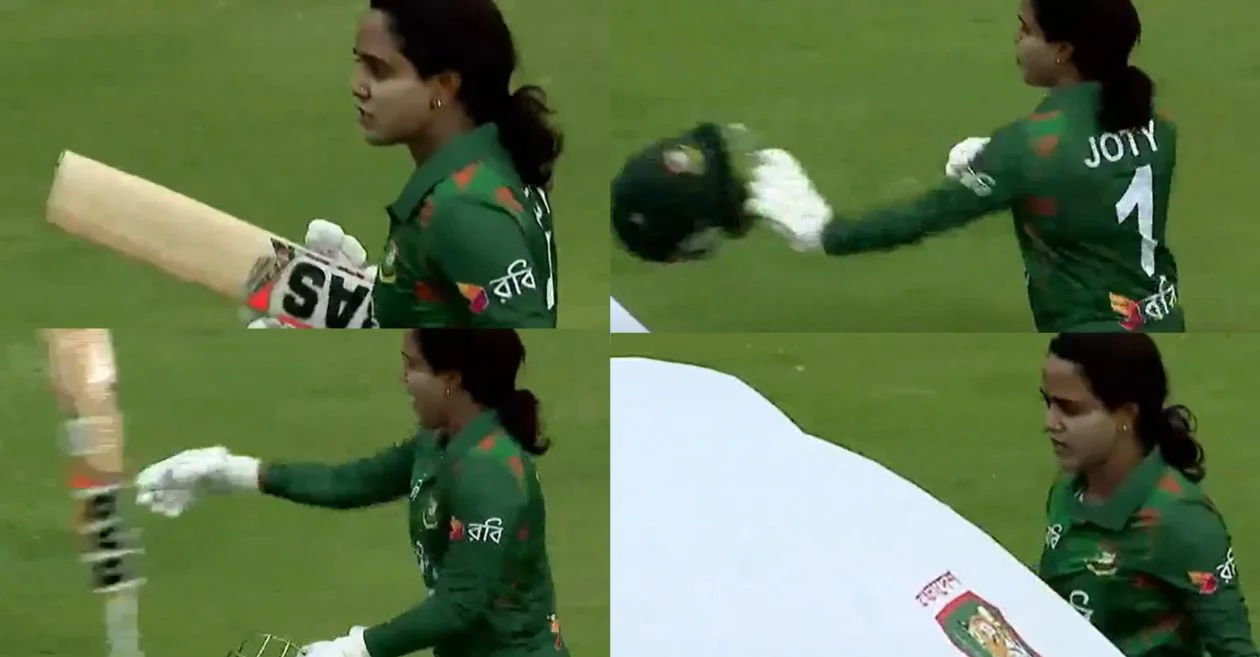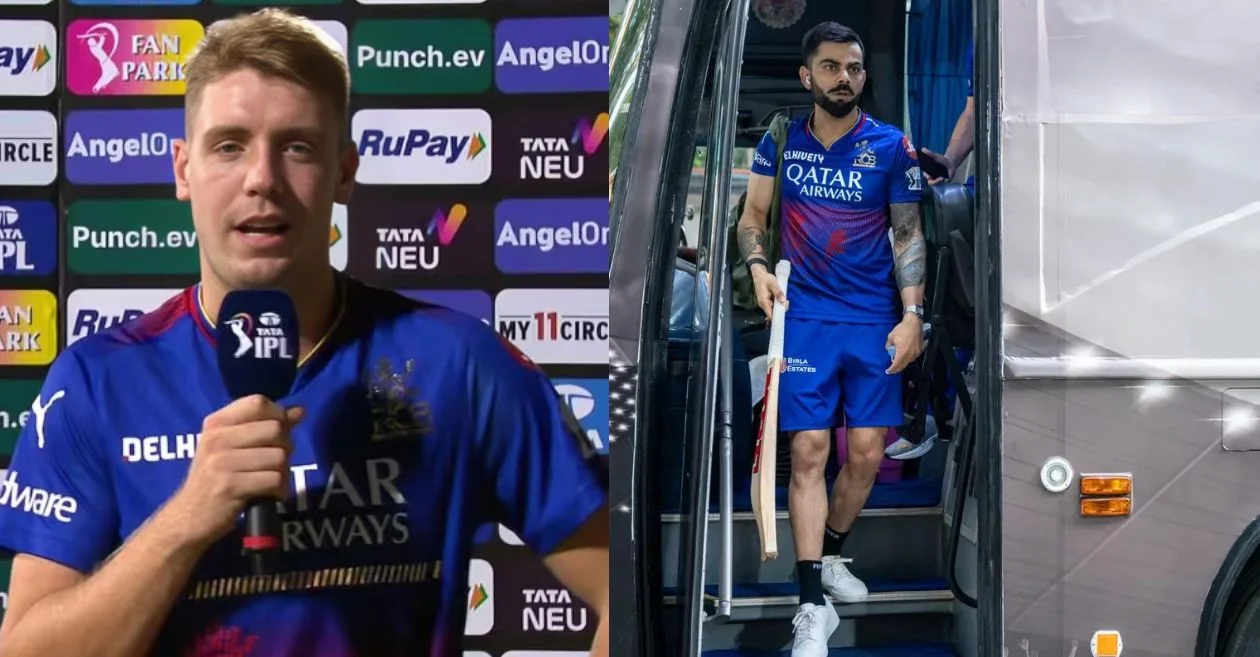
Revisiting the Seahawks’ decision to trade Russell Wilson to the Broncos.
Today is the two-year anniversary of the Seattle Seahawks’ seismic decision to send Russell Wilson to the Denver Broncos. If you need a reminder as to the full details of the trade, take a look at this:
The Russell Wilson trade is now complete. pic.twitter.com/ZnELGvPHfD
— Seattle Sports (@SeattleSports) April 28, 2023
Prior to the draft, it sure looked like the Broncos were winners by default because they had Wilson, Super Bowl champion and one of the best at his position for years, while Seattle had Geno Smith and Drew Lock as their quarterbacks. Heh.
This is a special edition of Winners and Losers, which aims to be Seahawks-centric, but may stray outside of those parameters on occasion.
Winners
John Schneider
Russell Wilson is better than he’s shown in 2022 so far but the probability that the Seahawks traded him at juuuuuuuuust the right time is skyrocketing
— John Fraley (@johndavidfraley) September 26, 2022
I’m more convinced than ever that Schneider would’ve been out of a job had he given into the demands of paying Wilson one more humongous contract. At the time, I was pretty pissed because I thought the Seahawks should’ve kept Wilson and moved on from Pete and/or John. Only one person didn’t get fired out of the three main characters in this story.
The last two drafts have been encouraging and are a major part of why the Seahawks didn’t instantly collapse to the cellar after the trade. Charles Cross, Devon Witherspoon, and Boye Mafe represent 60 percent of the picks the Seahawks made through Denver’s draft picks. Pretty good, I’d say!
Schneider’s next job is to build the next contender without Wilson and Pete Carroll.
Geno Smith
“They wrote me off, I ain’t write back though.”
Geno Smith with a message pic.twitter.com/R1EaKpW3Dt
— ESPN (@espn) September 13, 2022
Whether or not Smith plays another down for the Seahawks is not relevant at this point. He was a draft bust turned backup quarterback to Messrs Rivers, Eli Manning, and Wilson. Russell getting dealt gave Geno an opportunity to be a starting quarterback and reach at least some of the potential that made him a high draft pick over a decade ago.
If you think he’s “mid” or not elite or whatever, then fine. Geno’s story was thought to have been written by the end of his New York Jets career, and now he’s on course for over $90 million in career earnings and a Comeback Player of the Year award.
Pete Carroll
/cdn.vox-cdn.com/uploads/chorus_asset/file/25324545/1433958256.jpg)
Photo by Tom Hauck/Getty Images
The end of the Wilson era essentially turned into a power struggle and a PR battle. When the trade happened, you’d be hard pressed to find opinions within the fanbase and in national media that were favorable of Pete more than Wilson. After all, we’ve had years of (ongoing) discourse over whether Carroll “held back” Wilson through play-calling, scheme, personnel, or whatever.
Not that Colin Cowherd is a great authority on anything, but don’t pretend this wasn’t a sentiment shared by many Seahawks fans at the time (and, honestly, even now).
.@ColinCowherd on why Russell Wilson left the Seahawks
“Seattle and Pete Carroll are running a 1999 offense. It’s Jurassic. It’s outdated.” pic.twitter.com/CPIMmcSwiC
— Herd w/Colin Cowherd (@TheHerd) March 17, 2022
This isn’t to say Pete didn’t impact Wilson and therefore the whole offense with terrible lines like the 2016 and 2017 groups, personnel moves, choice of offensive coordinators, or bad in-game management. What if maybe, just maybe, Pete always believed in Wilson and is one of the few coaches who would’ve ever given him a chance to succeed in the first place? What if Pete knew Wilson’s strengths and weaknesses and adjusted the offense accordingly? Early career Wilson was an elite dual-threat and a hugely important part of the run game through the read-option. Later career Wilson had two of his most efficient passing seasons after his open-field speed clearly started to go on him.
For all of Carroll’s faults, I think there should be a real re-assessment of not just how he views the quarterback position (see: Geno’s 2022 and the flip to a pass-first offense), but also the Carroll-Wilson partnership and how great it truly was. I suspect the narrative would’ve been a whole lot different if they’d won Super Bowl XLIX. Plain and simple.
There may be apologies in store from analysts who treated Carroll as a hindrance to Wilson and not one of his biggest supporters and vehicles for becoming one of the best quarterbacks in the sport. With that said, the story on Pete isn’t done.
Shelby Harris, Drew Lock, and Noah Fant
None of them experienced being on a playoff team until they came to the Seahawks. Obviously Lock didn’t play a regular season snap in 2022, but Harris and Fant were key contributors that year. Harris was the veteran of this trio, having been drafted by the Raiders way back in 2014. I’m happy they all got to experience meaningful January football right away.
Russell Wilson, the earner
Wilson’s on-field success may have been scarce, but he secured the bag. He got “Mahomes money” before he ever played a down. He never played a snap for Denver under the extended part of his contract. The Broncos are on the hook for a ton of money even after cutting Wilson. I’d say Wilson won the contract negotiations.
Losers
Russell Wilson, the quarterback
Seahawks legend Al Woods slams Seahawks legend Russell Wilson pic.twitter.com/wFk6CLvncx
— Curt ♂️ (@curtiss_brown21) October 8, 2023
There’s still a chance for Wilson to salvage his career as a starter wherever he plays next, but no starting quarterback’s on-field reputation has taken a bigger hit than Russ over the last two seasons. Yes, there are still glimpses of vintage Russ when he’s making these improbable throws to receivers, or firing off a pretty moon ball for a touchdown, but it’s abundantly clear that he is past his prime. Maybe the busted finger has accelerated that decline, but non-decisions like this one can’t be finger-related.
Greg Dulcich open before the pressure got to Russell Wilson. pic.twitter.com/LO56jdHxLY
— Zac Stevens (@ZacStevensDNVR) October 18, 2022
You know exactly what happened after this.
In hindsight, it was foolish to ever assume that his game would age as gracefully like Drew Brees, Tom Brady, or Peyton Manning. Years of apportioning the majority of the blame of his sacks on on the offensive line let him off the hook for the sacks he took because he held the ball too long or didn’t run the play as designed. I’m not above this, but I do owe a lot to the likes of Matty F. Brown, Griff Sturgeon, and others who painted a much clearer picture that wasn’t reduced to thinking Wilson was being “held back” by a Flintstones era offense.
At some point, it grows tiresome to repeatedly blame Wilson’s shortcomings on his coaches, his coordinators, and whoever is in charge of the roster. Wilson is not some helpless child and it’s probably well overdue to finally portray him as an independent adult. The mistake made in analyzing Wilson was assuming that in addition to being a gifted athlete, he could process the game at the same level as the consensus greatest passers in the history of the sport. It was evidently never true. He won a ton of games his way, and there was nothing wrong with that. But there were legitimate question marks regarding how he’d fare once his athleticism waned, and the results aren’t pretty.
I’ve shared this thread from a former Field Gulls contributor before, but it’s worth re-surfacing some of the points made because it’s more pertinent now than it was three years ago.
when he is in control of his abilities, he looks like a normal tier 1 quarterback. he beats pressure by standing tall in the pocket and getting the ball out on time. he beats zone with zone beaters and man with man beaters, he spreads the ball around to TEs and WRs and RBs.
— BestGuyNoLongerAround (@BestGuyAround) January 10, 2021
and then there’s the other guy.
he doesn’t trust his reads, or doesn’t read at all. he holds the ball. he fumbles snaps. he ducks into pressure. he intentionally, uh, groundings. he spins 20 yards into the backfield and takes sacks. he throws what-was-he-thinking interceptions.
— BestGuyNoLongerAround (@BestGuyAround) January 10, 2021
at his worst, he is simply not a functional quarterback. plays and entire drives are doomed before they start. he’s playing some other game in his head that none of the rest of us can see.
so here’s what drives me nuts about the guy, and the larger conversation surrounding.
— BestGuyNoLongerAround (@BestGuyAround) January 10, 2021
both of these versions of the quarterback exist, and have always existed, regardless of who is calling the offensive plays, and regardless of the weapons the front office has (or hasn’t) afforded him, and the talent lining up across from him. he transcends, or he doesn’t.
— BestGuyNoLongerAround (@BestGuyAround) January 10, 2021
every season we see the A+ russell wilson and the C- russell wilson, and in year 9 it is beyond tiresome to get more of the latter than the former and still hear the same stuff about the coaches or the play selection or the talent around him or the strength of the opponents.
— BestGuyNoLongerAround (@BestGuyAround) January 10, 2021
Wilson is entering Year 13, and the C- version of Wilson is more prominent than the A+ one that only seems to emerge consistently in 4th quarter situations. The whole “Let Russ Cook” movement also had a clear flaw in the plan: Wilson can’t be trusted to throw more unless he could attack the middle of the field more often and get sacked less often. He does neither and continues to do neither post-Seattle. Throwing the ball more on early downs was a way too simplistic view of how the Seahawks could maximize the offense with Wilson at QB.
I’ve admittedly rolled my eyes at “controversies” like the wristband, the high knees on the plane, and whatever Kyle Brandt’s beef is with Russ, but the Wilson brand is also in tatters. This is three straight seasons of sustained losing, and consequently his public persona and speeches do not hit the same as they did in Seattle. It’s a rebuild for Russ in more ways than one. He’s still a starting-caliber quarterback, but expecting anything close to elite play again is likely a fool’s errand.
Touchdown-Interception ratio as a primary means of quantifying QB play
This is a tweet that Russell Wilson liked on his personal account.
Russell Wilson is now getting BENCHED despite outplaying some of the leagues biggest “stars”
Wilson 2023:
Passing TDs: 26
INTs: 8
Yards/Attempt: 6.9
Rushing TDs: 3Mahomes 2023:
Passing TDs: 26
INTs: 14
Yards/Attempt: 6.9
Rushing TDs: 0Make it make sense… pic.twitter.com/UPxfJEjK4G
— Fantasy Fanatics (@FFB_Fanatics) December 27, 2023
Wilson’s 2023 was clearly better than his 2022, and of course he’s going to agree with it given the tumultuous benching after they were out of playoff contention.
Touchdown-interception ratio in itself is not a valueless statistic. It is also not a great metric to measure how well a quarterback is actually performing. Anyone who saw Wilson’s 2023 knew that he was not remotely as good as a 26 TD/8 INT ratio suggested. He excelled in the red zone, remained a very good deep passer, and that is effectively it.
It is almost implied that interceptions are the only way that you can damage your offense. Wilson’s sacks were once the price to pay for all of his magical out-of-structure plays, but now the trade-off isn’t there anymore.
While Russell Wilson was better in 2023 than 2022, that sack rate would scare me off, even at the veteran’s minimum.
Most DYAR lost on sacks, 2023:
1. Bryce Young (-1136)
2. Sam Howell (-993)
3. Zach Wilson (-824)
4. Justin Fields (-796)
5. Russell Wilson (-777)— Bryan Knowles (@BryKno) March 5, 2024
Denver ranked 24th in three-and-out rate, which is the seventh consecutive season a Wilson-led offense has been in the bottom-half of the league in that department. It’s also the sixth time he’s been in the bottom third. But at least he’s not turning the ball over, right?!
The Buffalo Bills can live with Josh Allen’s propensity for turnovers when he’s one of the best dual-threat quarterbacks in the league. Not a sensible soul would argue that Wilson was on par with Allen because his TD/INT ratio was 26/8 to Josh’s 29/18. Lamar Jackson had a 24/7 TD/INT ratio and as many total touchdowns (29) as Wilson, but one of these QBs was league MVP and the other one was not.
The ways Wilson can wreck an offense will not be through increased interceptions; it will be through even more drive-killing sacks and missed reads to open receivers. You can fanfic your way into any hypothetical about how he’d have fared with this coach or that playcaller, but the only offense that he runs (and previously ran it very well) is the Russell Wilson offense. It’s a hell of a lot harder to operate the Wilson offense without the requisite athleticism to elude pass rushers.
Pete Carroll
Yeah, he can be in both columns. Carroll doesn’t have a head coaching job and no longer has a say in the roster construction. In an alternative world where the Seahawks kept Wilson, didn’t have draft picks to restock certain positions with young talent, Pete might have gotten removed from his position even sooner than what actually happened.
I will argue that Carroll the front office guy made it harder for Carroll the coach to succeed. The drafts that resulted in L.J. Collier, Marquise Blair, Tedric Thompson, Lano Hill, Tre Flowers, etc. as building blocks to replace the Legion of Boom directly caused the shortage of talent on the defensive side of the ball. His inability to build another good defense was untenable, and it’s not like he lacked investment (cough)Jamal Adams trade(cough).
If 2022 was a pleasant surprise, 2023 was the reality check hook to the jaw. It’s hard to sell to “non-football people” that the Seahawks are close to contention when you’ve got one division title in seven seasons and have been resoundingly defeated in the playoffs by your top two rivals. Carroll ran out of time and chances to right the ship, and perhaps it was better for him to go out as a Week 18 winner without a playoff berth than risk a Tom Landry-esque downfall. Don’t let the final years cloud what a great era of football he provided.
George Paton, Broncos GM
He probably shouldn’t be the GM anymore. Ideally, he remains the GM and the Seahawks can squeeze out some more deals with him.
Russell Wilson: Paton’s historic trade
Randy Gregory: Paton signed him in 2022.
Justin Simmons: Paton extended him in ’21.
Brandon McManus: Elway extended him in 2020.
Frank Clark: Paton signed him last year.
Montrell Washington: ’22 draft pick.
See a trend? https://t.co/oPH3bg0h6L
— Joe Rowles (@JoRo_NFL) March 7, 2024
Nathaniel Hackett
That might’ve been the worst coaching debut ever lmfao
— Johnny Baboon (@shirts0) September 13, 2022
Sean Payton could end up in shambles as the Denver Broncos rebuild. He has a Super Bowl win and a deep track record of playoff appearances and division titles with the New Orleans Saints.
Hackett worked with Aaron Rodgers a couple of years and parlayed that into a head coaching job. Between the awful Broncos gig and the ongoing New York Jets disaster, Hackett is going to be a laughing stock until further notice. Adam Gase 2.0 but somehow more incompetent.
And for that, we thank him eternally for being so awful at his job that the Seahawks now have Devon Witherspoon.















You must be logged in to post a comment Login